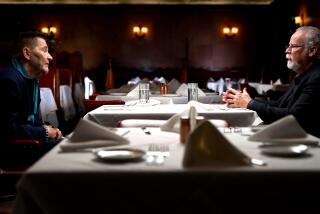Ethnically Diverse ‘Twilight’ Jury Came Together on Very First Ballot
- Share via
To attorneys, defendants and spectators, the “Twilight Zone” jurors seemed inscrutable as they listened attentively to 10 months of testimony and argument, their poker faces seldom betraying the slightest reaction.
But while the prosecutor and defense attorneys inveighed against each other both inside and outside the courtroom, the seven men and five women on the panel were getting along famously.
It took them nine days to reach a verdict, they told reporters Friday, but only because they wanted to be thorough, particularly since most were serving as jurors for the first time.
“We wanted to be absolutely sure,” foreman Lois Rogers said during a news conference in the courtroom after director John Landis and four co-defendants were acquitted, “and we wanted to give everyone a chance to put their two cents’ worth in.”
Inescapable Conclusion
When it came time for a vote, however, only one ballot was needed. The conclusion, they said, was inescapable.
The helicopter crash on the movie set, which claimed three lives, amounted to “an unforeseeable accident,” said Rogers, a 59-year-old North Hollywood homemaker, adding: “You don’t prosecute people for unforeseeable accidents.”
Chosen from among 110 prospective jurors, the panel was ethnically diverse, aged 38 to 74. Included in their ranks were a painter, a glassworks repairman, a machinist, a clerk-typist, a shipper, two hospital employees, a budget analyst, a chemist and a retired colonel for the Army Corps of Engineers.
Even so, they were unfazed by the Hollywood razzle-dazzle that went along with the trial. “We didn’t see the glamour,” Rogers said, and apparently the only celebrity spectator they recognized was actor Ralph Bellamy.
Unfairly Singled Out
In their view, they said, the five defendants were unfairly singled out. If Landis and his co-defendants were guilty, said juror Lauretta Hudson, a retired hospital worker, “so were the firemen and the people on the set” the night of the accident.
If anything, several jurors said, the biggest contributor to the crash was James Camomile, the special-effects man whom the defense accused of igniting the lethal explosive before the helicopter was safely out of the way.
“He was supposedly watching Vic Morrow and the children and not watching the helicopter,” juror Arizona Watkins, who works for the Los Angeles Community College District, said in an interview.
But added Watkins, 58: “It was human error. I really believe that.”
Jurors apparently were dissatisfied by the prosecution’s failure to explain precisely why the crash occurred.
“I also felt there was not enough evidence brought out that proved the reason that the accident happened,” Hudson, 68, said at the news conference. “I mean, a straw through a potato meant nothing,” she added, referring to Deputy Dist. Atty. Lea Purwin D’Agostino’s attempt during closing arguments to suggest the vulnerability of the helicopter.
Hudson said jurors “were more impressed” with the defense theory that heat from a fireball caused the helicopter’s tail rotor to come apart in a freak occurrence that could not have been foreseen. “That at least was proven to us,” the juror said.
Other jurors, however, quickly added that the cause of the accident did not play a major part in their deliberations. They were instructed by Superior Court Judge Roger Boren to ignore it.
Praise for Prosecutor
Although they disagreed with D’Agostino, jurors had praise for her overall presentation: “I give Mrs. D’Agostino all the credit in the world,” Rogers said. “She did very well with what she had to work with.”
At the same time, Rogers said, referring to the 71 people the prosecution called to the stand, “I think there were a lot of extraneous witnesses.”
Roger Aker, who works for a glass manufacturer, said he was “awe-struck with (D’Agostino’s) delivery,” but he was also critical of her for “dragging it out.”
“There’s a saying, I have it on my wall at work,” Aker said in an interview. “It goes something like: ‘People go on talking long after they’ve said what they have to say.’ ”
During their 10 months of service, the jurors went through a lot together, they said--deaths in the family, graduations and eight birthdays. They developed a system to deal with birthdays, Rogers said:”The person that had the birthday had to bring the cake.”
So it was that on Friday, when their verdict was announced, Junus Rachal of Huntington Park left the courtroom with a pink box and the remnants of a cake. It was the eve of his 60th birthday.
It may have been their last courtroom birthday celebration, but they have vowed that it will not be their last party, Watkins said. In fact, they have already scheduled a reunion for November.
“We all plan to stay in touch,” she said. “We got to be very close.”
Times staff writers Cathleen Decker and John Kendall contributed to this story.
More to Read
Only good movies
Get the Indie Focus newsletter, Mark Olsen's weekly guide to the world of cinema.
You may occasionally receive promotional content from the Los Angeles Times.










